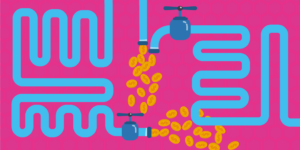Seasonal businesses take advantage of heavy demand for a product or service within a concentrated period of time. While this model can offer many opportunities, it can also present significant business cash flow management challenges. One of the biggest challenges facing seasonal businesses is cash flow. Making sure you have enough cash on hand to pay your expenses all year round can be tricky when you’re earning most of your revenue during only part of the year. Navigating the cash gap successfully takes careful planning and discipline, which you can start to cultivate using the steps below.
Understanding Seasonal Cash Flow Problems
Seasonal cash flow problems are a common challenge for businesses that experience fluctuations in revenue and expenses throughout the year. These issues arise when a business’s income is concentrated in specific periods, leaving gaps during off-seasons. Industries like tourism, agriculture, and retail often face these challenges, as their revenue streams are heavily dependent on seasonal demand. When cash flow problems occur, it can be difficult for businesses to pay bills, purchase inventory, and cover other essential expenses during the off-season. Understanding these problems is the first step in developing strategies to manage cash flow effectively throughout the year.
Recording Cash Flow
Before you can successfully manage your cash flow, you need to understand the cash flow challenges that arise, especially in businesses with seasonal fluctuations. Mapping out your current revenues and expenses is the first step. This is called a cash flow statement. You can use different methods for creating your cash flow statement, but the end result is a realistic picture of the cash coming into your business as well as the cash going out. When you track your cash flow correctly, you should be able to tell how much cash you have on hand and whether your cash flow is generally trending positive or negative.
Inflows
Cash inflows consist of any cash that is coming into your business, including funds from sales, royalties, dividends, interest, sale of property and more.
Outflows
Cash outflows are your business’ expenditures. These can include fixed monthly costs such as rent or internet service, variable monthly costs such as utilities or variable expenses that happen other than monthly (such as quarterly taxes or annual insurance payments). All of these need to be accounted for to give you an accurate portrayal of your outflows.
Timing
Time is a crucial element in a cash flow statement. Particularly in seasonal businesses, time periods of high inflows may not match up with time periods of high outflows. Knowing when cash is coming in and going out is integral for effective cash flow management techniques.
Identifying High and Low Cash Flow Periods
For seasonal businesses, identifying high and low cash flow periods is crucial for effective financial management. By analyzing historical data and sales trends, businesses can pinpoint when they experience peak revenue and when demand typically dips. Reviewing cash flow statements from the worst-performing months can provide valuable insights into low cash flow periods. This analysis helps businesses prepare for these fluctuations by developing strategies to manage cash flow during both peak and off-peak seasons. Knowing when to expect cash inflows and outflows allows for better planning and ensures that the business remains financially stable year-round.
Forecasting Cash Flow
Once you have all possible information on your past and current cash inflows and outflows, you can forecast future flows based on that data. If you are a new business, you may have to rely on other data to create your forecast, such as industry standards or the experience of similar businesses. The more data you have, the more accurate your forecasts will be. Take the time on a day-to-day basis to know where you are in your current accounts, and keep your cash flow forecast updated based on your latest experience and information. It’s best practice to forecast a year ahead and update your forecast at the end of every month. In a seasonal business, your expenses may be highest just before or at the beginning of your busy season — the exact time when your cash reserves may be at their lowest. Make sure you account for major expenses that precede your high season, such as buying new inventory or hiring more staff, and plan for slow periods when revenue may decline.
Forecast a Cash Flow Cushion
A forecast is always a well-informed guess of what your inflows and outflows will be. It’s never going to be completely accurate — and those differences may or may not be in your favor. When planning your forecast, it’s usually wise to build in a contingency allowing you a cushion of 20 percent to 30 percent, which will help you absorb the inevitable variances from your forecast.
Creating a Comprehensive Cash Flow Forecast
Creating a comprehensive cash flow forecast is essential for seasonal businesses to proactively manage their finances. This forecast helps anticipate times of negative cash flow and allows businesses to plan accordingly. Start by identifying all cash inflows and outflows, estimating revenue and expenses, and considering seasonal fluctuations. A detailed cash flow forecast should cover at least a year and be updated regularly to reflect the latest data and trends. By having a clear picture of future cash flow, businesses can make informed decisions about staffing, operations, and other critical aspects of cash flow management, ensuring they are prepared for both peak and off-peak periods.
Managing Seasonal Cash Flow
Your cash flow forecast can show you where your cash flow gaps will be. Once you can see how much your expenses will be and when they’ll be due, you can take steps to create a budget that will help you make sure you can meet your off-season obligations. Here are several ways to start managing your seasonal cash flow.
Save for the Slow Season
Your budget should include provisions for saving money during your peak season to help cover expenses when it’s slow. Having this reserve in place will help you make sure can keep the business going smoothly all year round.
Start an Emergency Fund
Emergencies do happen. If you need to replace a major item of equipment during your slow season, for example, the funds for such a purchase may be hard to come by if sales are down. You can anticipate such expenses by establishing an emergency fund equal to about one to three months of average business expenses. Just make sure you don’t give in to the temptation to dip into this fund unless it really is an emergency!
Open a Line of Credit
Another way to make sure you have cash on hand is to establish a line of credit that you can draw on if needed, only paying interest if you actually borrow any money. This is something you’ll want to do in advance — before you need it — in order to get the best terms and best chance of approval. Planning ahead means you can have your line of credit ready and waiting when (or if) necessary.
Continue Cutting Expenses
Are you paying year-round for facilities or employees that you only really need during your high season? Look at your slow-season expenses to see what you might be able to cut. For example, you may be able to suspend subscriptions or other fixed expenses during times when you don’t need them. Or instead of hiring full-time employees for the full year, you could hire contract or part-time employees when you really need them.
Negotiate Payment Terms
Talk to your creditors about the seasonal nature of your business. You may be able to negotiate terms — making higher rent payments during your busy season, or getting extended payment terms from vendors during your slow season, for example. If you work this out in advance, it’s going to be easier for them to absorb and you’ll have more leverage.
Diversify Your Business
Adding other revenue streams to your business can be a smart way to manage a cash flow gap. Do you have a property that sits idle during your offseason? Maybe you could rent out space. Or is there another part-time business that you might be interested in starting to fill the gaps during your slow season? For example, a landscaping business might do snow removal during the winter. Anything that can diversify your sources of income can help you cover any gaps that arise.
Managing Cash Flow During Peak Seasons
Managing cash flow during peak seasons is vital for maintaining a positive cash flow and ensuring the business can thrive during off-peak periods. During these busy times, prioritize cash flow management by controlling expenses, managing accounts receivable efficiently, and optimizing inventory levels. By keeping a close eye on cash inflows and outflows, businesses can build cash reserves that will help cover expenses during slower periods. Effective cash flow management during peak seasons sets the foundation for financial stability and allows businesses to navigate the challenges of seasonal fluctuations with greater ease.
Managing Cash Flow During Off-Peak Seasons
During off-peak seasons, managing cash flow becomes even more critical to maintain financial stability. Focus on cost-cutting measures, such as reducing staff and scaling back operations, to minimize cash outflows. Additionally, manage expenses like rent and utilities carefully to ensure they align with the reduced revenue. By implementing these strategies, businesses can maintain a positive cash flow even during slower periods. Preparing for the next peak season involves careful planning and disciplined cash flow management, ensuring the business remains resilient and ready to capitalize on future opportunities.
Mind the Seasonal Gap and Cash Flow Challenges
The time to think about a cash flow gap is long before it occurs. By forecasting an accurate picture of oncoming cash flow issues and giving yourself plenty of time to plan ahead, you can successfully solve any cash flow gaps and keep your business thriving — no matter the season.





















